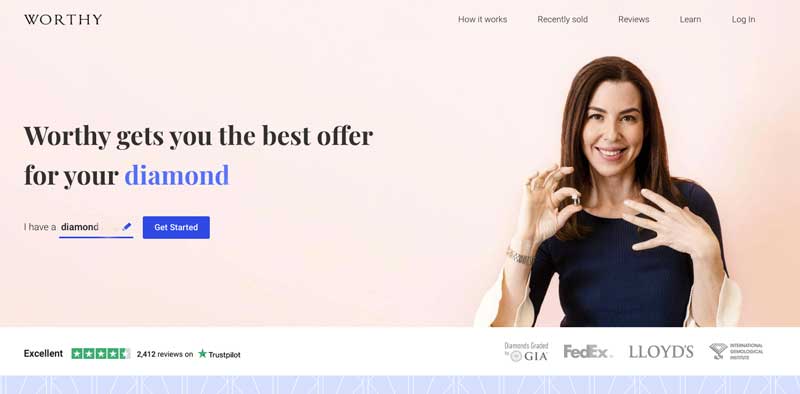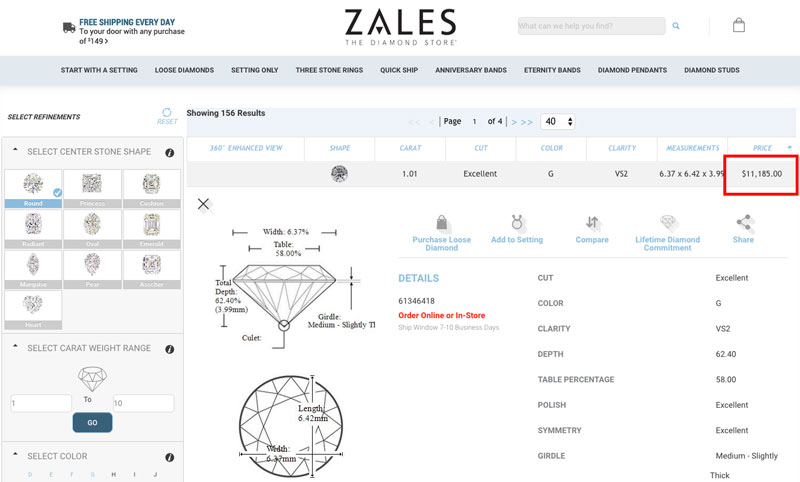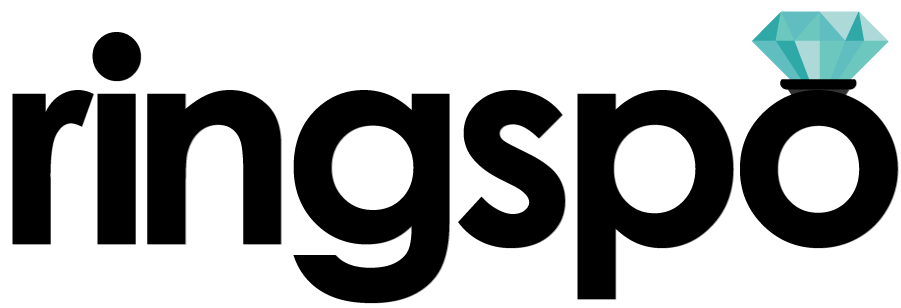Looking to sell a loose diamond?
Learn how to sell your loose diamond and get the best possible price
Selling a loose diamond can be a tricky business – you want to make sure that you get a great price, and also that you’re safe and secure throughout the transaction.
Here’s what you need to know: what you have will determine where you should sell:
- Above 1.2 carats: The Diamond Oak
- 0.5 – 1.2 carats: Worthy.com

Ringspo is reader supported
Ringspo is reader-supported, which means we may receive a commission if you click a link to a retailer & subsequently make a purchase.
We feature links to several retailers to help readers find the one that is the best fit for them. Find out more about how Ringspo works here.
Diamonds are not investments and rarely increase in value
We want to get this out of the way straight away. Diamonds are generally not good investments and do not usually increase in value over time at a rate greater than inflation.
Here’s how the price of a 1 carat diamond has changed over the last 12 months:

There are some exceptions to this: colored diamonds.
Coloured diamonds are much rarer than white diamonds and as a result often do increase in value over time.
The rarer the color, the more likely they are to increase – you can see in the graph below that pink diamonds have increased in value more than blue diamonds,

Understanding how much your loose diamond is worth
There are many values that are assigned to a diamond throughout its life.
When selling a diamond though, there’s only one that matters: what someone will actually pay you.
It’s much more accurate than any kind of diamond price calculator ever could be.
However, it’s important to understand each of the values that can be assigned to a diamond and how they relate to each other.
Retail value
This is the price that was actually paid for a diamond.
While it’s common to look at a ring in a store and assume that a diamond which still looks the same is worth that, a diamond that is being sold will will usually be valued at around 50% of the original price paid.
Replacement value of your loose diamond
The replacement value is the amount that an insurance company has agreed to pay if the diamond is lost or stolen.
Replacement values are usually quoted on ‘appraisals’ and unfortunately are often overstated, sometimes being higher than the initial purchase price.
This can make understanding how much you are actually likely to receive when you sell your loose diamond more difficult.
Secondary market value of your diamond
This is the amount that your diamond will be able to be sold for by the person who buys it from you.
Understanding the secondary market value for your diamond can help you understand what the fair market value for your diamond is likely to be e.g. if a ring featuring a pre-owned diamond is currently being sold for two-thirds of the original purchase price in a store, the owner of that store would have to have bought it for less than that.
Fair market value
Fair market value is the amount that someone is actually be willing to pay for your diamond.
When you’re selling your stone, this really is the only value that matters.
This can be subjective, depending on the individual buyer’s needs at that time.
One of the best ways to understand the current fair market value is to look at recent sale prices. Worthy.com has an excellent tool which shows
A great feature is that you can use the dropdown menus to find a diamond with the same carat weight and quality specs as yours. It’s definitely worth clicking through to understand what people are actually paying for loose diamonds.
Learn the best place to sell your loose diamond
The best place to sell your diamond will depend on exactly what it is you are selling.
For example, the best buyer for a top quality 3 carat emerald cut diamond is different to half carat SI2 clarity round brilliant.
We conducted a test in our article to find the best place to sell a diamond ring where we assessed 8 different types of organisation or companies that you could sell to.
Best place to sell a larger, or high quality loose diamond
We’ve conduced several mystery shops of diamond buyers over the last three years and have found The Diamond Oak consistently offers the highest prices for larger and higher quality diamonds.

Alon is a 3rd generation diamond dealer, operating out of the heart of New York’s Diamond District. He deals solely in higher carat and quality diamonds and as a result can always ensure that he is offering the best price
If you have a larger (1.2 carats or above) and high quality diamond, I recommend you click below to learn more and read some of the reviews from people who have had great experiences with Alon.
Best place to sell a medium-sized loose diamond
If you have a medium-sized diamond (0.5 carats – 1.2 carats), or your diamond is a little lower on color grade or clarity, we recommend you sell through worthy.com

Worthy is an online marketplace that connects diamond sellers to a network of diamond buyers.
The advantage of this is the number of people that Worthy can get your diamond in front of. The example below is a 1 carat princess cut with J color and I1 clarity.
‘I1’ clarity means that this stone is ‘included and would have some flaws which are relatively easy to see with the naked eye.

‘I1’ clarity means that this stone is ‘included and would have some flaws which are relatively easy to see with the naked eye.
However, there were buyers interested in this diamond, which resulted in a good price for the seller.
How to sell a loose diamond
When you’re selling a loose diamond, it can be tempting to go for a quick, easy sale. However, doing do can mean that you receive significantly less than you should.
If you’re in a hurry to sell and simply Google ‘diamond buyers near me’ and then choose the first on the list, it’s likely that you will receive significantly less for your diamond than you should.
In this section we’ll look at 8 steps to take when selling your diamond to maximise your selling price.

Following these steps to learn how to sell a loose diamond will ensure you are comfortable with your decision to sell and happy that the price you receive for your loose diamond is fair.
- Decide whether you are ready to sell
- Selling a diamond is a big decision, but not your only option. Your diamond could also be repurposed, or could be handed down or gifted, if appropriate.
- Understand what your diamond originally cost
- Knowing the original price of the loose diamond can be helpful in understanding approximately how much you are likely to receive
- One thing to know is that different retailers charge wildly different amounts for identical diamonds – sometimes up to double. If you paid a higher than average price originally, this doesn’t mean you will get more when it comes to selling.
- Come to terms with the fact that you won’t get the price you paid
- Most people prefer to buy diamonds new, which is understandable with such a meaningful purchase.
- As a result, anyone that is going to buy your diamond will only be prepared to offer you less than you originally paid for it.
- As a ballpark figure, a loose diamond usually has a resale of between 40% – 50% of the price paid.
- Find your grading report of diamond certification (if you have one)
- Being able to supply a grading report from an independent lab will ensure that the buyer has confidence that your diamond really is of the quality you are claiming.
- Find your appraisal (if you have one)
- While an appraisal is useful to be able to supply to a potential buyer, it won’t affect the price you receive.
- The price offered is the ‘replacement value’ and often higher than it would cost to buy the equivalent diamond new, let along second hand.
- Understand the different places you could sell your loose diamond
- There are many types of places you could sell your diamond:
- Diamond specialists and dealers e.g The Diamond Oak
- Online start-ups e.g. Worthy, I do now I don’t
- General online marketplaces e.g. eBay, Craigslist, Facebook Marketplace
- Local jewelers
- Antique stores
- There’s ‘one size fits all’ solution for the best place to sell your diamond – it will depend what you are selling
- There are many types of places you could sell your diamond:
- Source multiple quotes
- It’s a good idea to source more than one quote, to ensure you are getting the best possible price.
- Some buyers can offer up to twice as many as others, and the more patient you are, the more likely you are to receive a higher offer.
- Select the buyer that best fits you
- This is most likely to be the diamond buyer that offers the highest price.
- However, other factors can also come into play – how secure you feel the transaction is, how easy the process is and how it fits with your desired timescale for the sale.
Following these steps will ensure you are as comfortable as possible throughout the process of selling your stone.
Factors that affect how much you will receive for your loose diamond

We’ve already looked at how where you choose to sell your loose diamond can make a huge difference to how much you receive for it.
But there are many factors to do with the diamond itself that can also have a huge effect, some of which are surprising.
The price you paid for your diamond won’t affect the price you can sell it for
There can be a huge difference in price for diamonds when sold new. If we look at a 1 carat, G color, VS2 clarity diamond, it can be bought online for just over $5,000:

If it was being bought new from a chain jeweler, it would cost considerably more.
Zales charges $11,185 for a diamond with the exact same specs:

Zales is charging more than twice as much for an identical diamond.
Despite this significant difference in purchase price, the diamond will be worth the same when it comes to sell.
What this means if you paid a higher original price at a bricks and mortar or designer brand retailer, then the difference between the price you are able to realise when selling and the price you paid will be greater.
That can be difficult to come to terms with, but unfortunately it’s the reality when some retailers charge significantly more for similar merchandise
Diamond grading report and how it can affect the price you receive
As well as the 4 Cs of your diamond, another factor that will affect how much it is worth is its diamond certificate, or as it’s more properly known: ‘grading report’:

Grading reports are different from appraisals as they are prepared by an independent lab rather than a jeweler. They also don’t assign a value to a diamond but they are a key factor in deciding how much a diamond is worth.
There are several different grading labs that assess diamonds, with some having a reputation for strictness and consistency while others are more generous with their gradings – known as ‘overgrading’.
As a result, the same diamond can be graded very differently from different labs. In a test by a diamond industry publication, one diamond was graded as G color by GIA and D by EGL Israel:

The GIA has graded this diamond much more strictly and it is likely that this is a more accurate grade. As a result of this strictness, the diamond trade trusts that certificates from GIA are accurate and trustworthy and is willing to pay more for a diamond with these certificates.
If your diamond has a certificate from a lab other than GIA or AGS, or if your diamond only has an appraisal and no grading report, the diamond seller may offer you less than a diamond that has been graded by one of those two organisations, as there is a chance that it has been overgraded and is actually lower in quality than the report indicates.
Our recommendations again to get the most for your loose diamond

If your diamond weights 1.2 carats or more, or if it has a designer name attached to it e.g. Tiffany & Co. or Van Cleef & Arpels, I recommend you contact Alon at The Diamond Oak to get the best price possible.
He is a dedicated diamond dealer who specialises in larger stones and ‘signed’ jewelry and consistently offers the highest prices.

For most diamonds between 0.5 and 1.2 carats, then Worthy, with their extended network of diamond buyers, is the best option.
Worthy is a marketplace which connects people with jewelry to sell with a network of jewelry buyers. It’s a great way to get your diamond in front of as many people as possible who will then bid against each other which can increase the sale price.


